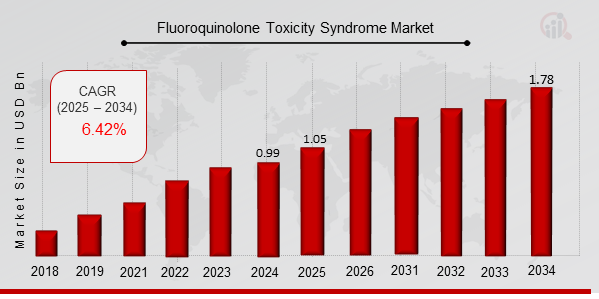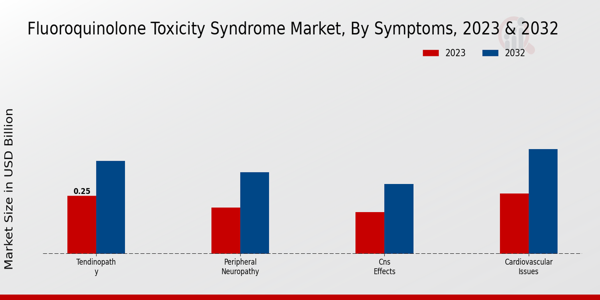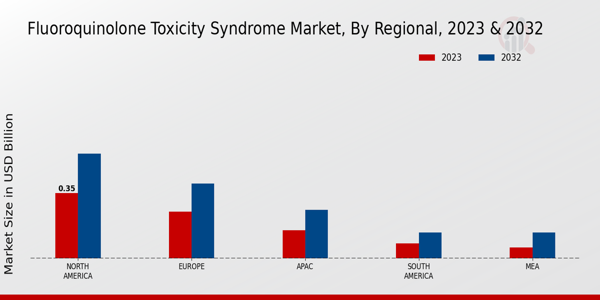Fluoroquinolone Toxicity Syndrome Market Overview
As per MRFR analysis, the Fluoroquinolone Toxicity Syndrome Market Size was estimated at 0.99 (USD Billion) in 2024. The Fluoroquinolone Toxicity Syndrome Market Industry is expected to grow from 1.05 (USD Billion) in 2025 to 1.78 (USD Billion) till 2034, at a CAGR (growth rate) is expected to be around 6.04% during the forecast period (2025 - 2034).
Key Fluoroquinolone Toxicity Syndrome Market Trends Highlighted
The Fluoroquinolone Toxicity Syndrome Market is driven by increasing awareness of the adverse effects associated with fluoroquinolone antibiotics. Healthcare providers and patients are becoming more informed about the potential risks, leading to a shift in prescribing practices and patient management strategies. This heightened awareness supports the demand for alternative treatment options and more rigorous safety assessments of fluoroquinolone drugs. Moreover, regulatory bodies are taking steps to reassess the safety profiles of these medications, especially for vulnerable populations, which further influences market dynamics. There are significant opportunities to be explored within this market as researchers and pharmaceutical companies look for safer antibiotic alternatives.The need for innovative therapies that can mitigate the risks associated with fluoroquinolone usage is apparent. Additionally, the growing focus on personalized medicine presents a chance to develop tailored treatment plans for patients at risk of toxicity. This pursuit not only addresses safety concerns but also aligns with broader trends toward individualized healthcare solutions, which are gaining traction in the industry. Recently, the market has seen trends toward increased pharmacovigilance and post-marketing studies to monitor the long-term effects of fluoroquinolone exposure. There is a noticeable increase in collaboration between regulatory agencies and pharmaceutical companies to ensure better safety profiles for existing medications.The rise of patient advocacy groups has also played a crucial role in bringing attention to fluoroquinolone toxicity, further driving demand for safer alternatives. These concerns are prompting healthcare providers to reassess their treatment approaches, creating a ripple effect throughout the healthcare ecosystem underscoring the need for ongoing research and development in this arena. Overall, the market is poised for evolution as stakeholders respond to the shifting landscape driven by safety, effectiveness, and patient-centric care.

Source: Primary Research, Secondary Research, MRFR Database and Analyst Review
Fluoroquinolone Toxicity Syndrome Market Drivers
Increasing Awareness of Fluoroquinolone Toxicity
The growing recognition of fluoroquinolone toxicity syndrome is an important driver for the Fluoroquinolone Toxicity Syndrome Market Industry. As medical professionals and patients alike become more aware of the potential adverse effects associated with fluoroquinolone antibiotics, there is an increasing demand for comprehensive information and solutions related to this syndrome. Educational campaigns conducted by health organizations and patient advocacy groups play a crucial role in elucidating the risks of fluoroquinolone use.This awareness drives demand for alternative treatment options and encourages research and development efforts focused on better understanding the mechanisms that underlie fluoroquinolone toxicity. Affected individuals seeking information about their condition contribute to the market's growth by demanding innovative therapies, improved diagnostic tools, and patient-centered care strategies. Furthermore, increased awareness fosters dialogue among healthcare providers, leading to more informed prescribing practices.As the Fluoroquinolone Toxicity Syndrome Market develops, the need for robust clinical guidelines and treatment protocols will be paramount in ensuring patient safety and managing the risk profiles of fluoroquinolone antibiotics. Therefore, these educational initiatives and growing awareness levels significantly influence the growth trajectory of the market, setting the foundation for ongoing advancements in the field.
Rise in Regulatory Scrutiny and Guidelines
Another significant driver of the Fluoroquinolone Toxicity Syndrome Market Industry is the heightened regulatory scrutiny surrounding the prescription of fluoroquinolone antibiotics. Regulatory agencies around the world are increasingly examining the safety profiles of these drugs, leading to the establishment of stricter guidelines and warnings pertaining to their use. The implementation of these regulatory measures is intended to protect patient safety by minimizing the risks associated with fluoroquinolone prescriptions, particularly in vulnerable populations.As healthcare practitioners adopt these guidelines, there is a growing necessity for new therapeutic interventions and diagnostic tools to address the complications arising from fluoroquinolone toxicity. This regulatory environment drives innovation within the market, compelling manufacturers and researchers to formulate safer alternatives and conduct further studies into the long-term effects of fluoroquinolone usage, ultimately shaping the market landscape.
Growing Demand for Alternative Treatment Options
The increasing preference for alternative treatment options outside of fluoroquinolone antibiotics reflects a significant trend in the Fluoroquinolone Toxicity Syndrome Market Industry. Patients experiencing adverse effects from these medications are more likely to seek alternative therapies, leading to a rising demand for safer antibiotic alternatives and complementary treatments. This shift in consumer behavior compels pharmaceutical companies to explore novel formulations and treatment modalities, creating a competitive market landscape.By investing in research that prioritizes patient safety, companies can cater to the needs of those seeking effective and less risky solutions for their medical conditions. This market driver not only reflects a change in treatment preferences but also underscores the importance of patient-centered care, which continues to gain traction in modern healthcare.
Fluoroquinolone Toxicity Syndrome Market Segment Insights:
Fluoroquinolone Toxicity Syndrome Market Symptoms Insights
The Fluoroquinolone Toxicity Syndrome Market has seen notable growth, particularly in the Symptoms segment, which encompasses various critical health issues stemming from the use of fluoroquinolone antibiotics. In 2023, this segment represented a market value of 0.89 USD Billion, showcasing its significance within the overall industry. The market is expected to expand, reaching a projected value of 1.5 USD Billion by 2032, highlighting a persistent upward trend driven by increasing awareness of fluoroquinolone-associated health risks among patients and healthcare professionals.Within this segment, Tendinopathy is a major contributor, valued at 0.25 USD Billion in 2023 and expected to grow to 0.4 USD Billion by 2032, making it the most dominant indicator of fluoroquinolone-related toxicity in patients, primarily due to the high prevalence of tendon injuries linked to these drugs. Peripheral Neuropathy also holds a significant position with a valuation of 0.2 USD Billion in 2023, progressing to 0.35 USD Billion by 2032, indicating an alarming rise in patients experiencing nerve-related side effects, emphasizing its importance in patient care and treatment plans.CNS Effects and Cardiovascular Issues further demonstrate critical health implications; CNS Effects are valued at 0.18 USD Billion in 2023 and are projected to increase to 0.3 USD Billion by 2032, reflecting growing concerns surrounding cognitive and neurological disorders post-treatment. Meanwhile, Cardiovascular Issues, valued at 0.26 USD Billion in 2023 and expected to see an uptick to 0.45 USD Billion by 2032, underscore cardiovascular systemic risks that can arise after fluoroquinolone usage. Collectively, these symptoms demonstrate the diverse range of adverse effects associated with fluoroquinolone toxicity.The growing prevalence of these conditions is influencing healthcare practices, with a focus on improving treatment protocols and developing better risk mitigation strategies to address these significant health challenges. The Fluoroquinolone Toxicity Syndrome Market is therefore essential not only for understanding patient experiences but also for guiding future research and development efforts in the healthcare industry.

Source: Primary Research, Secondary Research, MRFR Database and Analyst Review
Fluoroquinolone Toxicity Syndrome Market Diagnosis Method Insights
The Diagnosis Method segment of the Fluoroquinolone Toxicity Syndrome Market plays a crucial role in determining the presence and extent of toxicity caused by fluoroquinolone antibiotics. In 2023, the overall market was valued at 0.89 USD Billion, and this segment is characterized by a growing emphasis on accurate and timely diagnosis. Clinical examination remains fundamental in assessing patient symptoms and history, while laboratory testing is vital for identifying specific biochemical markers associated with toxicity. Imaging techniques, on the other hand, provide significant visual insights into potential damage caused by the antibiotics, making them essential for comprehensive evaluation.This segment demonstrates a trend toward improving diagnostic accuracy, driven by advancements in technology and an increasing understanding of fluoroquinolone-related adverse effects. The market statistics indicate that as healthcare providers become more aware of fluoroquinolone toxicity, the demand for sophisticated diagnostic methods is expected to rise, presenting opportunities for growth. The significance of each method lies in their contribution to informed clinical decision-making, ultimately aiming to enhance patient outcomes in the context of fluoroquinolone toxicity management.
Fluoroquinolone Toxicity Syndrome Market Treatment Approach Insights
The Fluoroquinolone Toxicity Syndrome Market, particularly in the context of the Treatment Approach segment, is valued at 0.89 billion USD in 2023, reflecting a significant focus on various methodologies for addressing this syndrome. The market is characterized by a variety of treatment options which include symptomatic treatment, physical therapy, and surgical intervention. Symptomatic treatment is crucial, as it addresses the wide array of specific symptoms associated with fluoroquinolone toxicity, enhancing patient comfort and recovery.Meanwhile, physical therapy plays a pivotal role in rebuilding strength and mobility for affected individuals, often dominating treatment protocols due to its effectiveness in mitigating long-term impacts. Surgical intervention, while less common, becomes essential in severe cases, emphasizing the market's comprehensive approach to tackling this complex health issue. The increasing awareness and prevalence of fluoroquinolone toxicity underscore the necessity for these treatment options, presenting opportunities for growth within the Fluoroquinolone Toxicity Syndrome Market.Overall, the segment reflects a balanced and multidimensional strategy to improve patient outcomes and enhance the quality of life for those affected by this condition.
Fluoroquinolone Toxicity Syndrome Market Risk Factor Insights
The Fluoroquinolone Toxicity Syndrome Market explored the important aspect of Risk Factors which are influential to the overall market dynamics. In 2023, the market was valued at 0.89 billion USD, reflecting the rising awareness and incidences of toxicity associated with fluoroquinolone medications. Among various factors, age is a critical determinant as individuals above a certain age tend to experience higher susceptibility to adverse effects, thus significantly impacting the market landscape. Gender also plays a role, with variations in pharmacokinetics and reporting of side effects influencing market data.Moreover, pre-existing conditions such as kidney disease or neurological disorders can exacerbate toxicity symptoms, making this aspect vital for therapeutic decisions and market growth. Concurrent medication is another important factor, as interactions with other drugs can heighten the risk of adverse events. Understanding these Risk Factors provides insights into the complexity and challenges faced in the Fluoroquinolone Toxicity Syndrome Market, which is projected to grow significantly in the coming years, driven by increasing awareness and the need for safer therapeutic options amidst current challenges in treatment protocols.
Fluoroquinolone Toxicity Syndrome Market Regional Insights
The Fluoroquinolone Toxicity Syndrome Market is experiencing substantial growth across different regions, with 2023 seeing a total market value of 0.89 USD Billion. North America holds a majority share, valued at 0.35 USD Billion, and is projected to reach 0.56 USD Billion by 2032, primarily due to its advanced healthcare infrastructure and research initiatives. Europe follows closely with a valuation of 0.25 USD Billion in 2023, anticipated to grow to 0.4 USD Billion, driven by increasing awareness and regulatory scrutiny over medication safety.The APAC region, valued at 0.15 USD Billion, is gaining momentum, reflecting rising healthcare expenditures and awareness, expected to rise to 0.26 USD Billion. South America and MEA, although at lower valuations of 0.08 and 0.06 USD Billion, respectively, in 2023, present significant growth potential, with their markets projected to increase to 0.14 USD Billion, underscoring a growing emphasis on pharmaceutical safety. These statistics illustrate the diverse landscape of the Fluoroquinolone Toxicity Syndrome Market, with North America and Europe dominating due to their established healthcare systems, while APAC, South America, and MEA represent emerging opportunities for market expansion.

Source: Primary Research, Secondary Research, MRFR Database and Analyst Review
Fluoroquinolone Toxicity Syndrome Market Key Players and Competitive Insights:
The Fluoroquinolone Toxicity Syndrome Market has garnered significant attention due to the rising concerns over the safety profiles of fluoroquinolone antibiotics. These medications have been widely prescribed for a variety of bacterial infections, leading to increased reports of adverse effects, primarily toxicity syndromes. This growing apprehension has propelled the demand for greater transparency in clinical outcomes and pharmacovigilance as stakeholders, including healthcare providers, regulatory bodies, and patients, seek to understand the risks versus benefits associated with these drugs. Competitive dynamics in this market are influenced by the regulatory scrutiny on safety profiles, product recalls, and the emergence of alternative treatment options. Thus, companies are under pressure to innovate and provide safer alternatives or improved formulations to retain their competitive edge.Pfizer has established a notable presence in the Fluoroquinolone Toxicity Syndrome Market by leveraging its extensive research capabilities and strong brand reputation. The company is recognized for its commitment to addressing safety concerns related to fluoroquinolone antibiotics through rigorous clinical trials and adherence to regulatory standards. Pfizer has developed a range of fluoroquinolone products that are designed not only to fight infections but also to minimize adverse effects associated with toxicity. Its strengths lie in its ability to invest substantially in pharmacovigilance programs and bolster post-marketing surveillance to ensure drug safety. Additionally, Pfizer's global marketing strategy emphasizes educating healthcare professionals about the potential risks while promoting awareness of its products' efficacy.Roche, on the other hand, has positioned itself strategically within the Fluoroquinolone Toxicity Syndrome Market by focusing on targeted therapies and innovative solutions. The company's approach to addressing fluoroquinolone toxicity involves extensive research into biomarkers and patient stratification to optimize treatment regimens. Roche's strengths are evident in its robust pipeline, which seeks to explore new therapeutic avenues that mitigate the adverse effects of fluoroquinolone therapies. The company also emphasizes collaboration with regulatory agencies to enhance safety measures and product labeling guidelines. Roche's commitment to patient-centered care and its proactive stance in public health discussions about fluoroquinolone usage reinforce its competitive stature in this evolving market. By prioritizing both scientific innovation and patient safety, Roche aims to maintain a leadership role amidst growing scrutiny in the pharmaceutical landscape.
Key Companies in the Fluoroquinolone Toxicity Syndrome Market Include:
- Pfizer
- Roche
- Teva Pharmaceutical Industries
- Mylan
- BristolMyers Squibb
- Johnson and Johnson
- GlaxoSmithKline
- AstraZeneca
- Eli Lilly and Company
- Bayer AG
- Amgen
- AbbVie
- Merck and Co
- Novartis
- Sanofi
Fluoroquinolone Toxicity Syndrome Market Industry Developments
Recent developments in the Fluoroquinolone Toxicity Syndrome Market have highlighted growing concerns regarding fluoroquinolone antibiotics and their safety profiles. Regulatory agencies have escalated scrutiny, resulting in heightened awareness among healthcare professionals and patients about potential adverse effects. Companies like Pfizer and Johnson & Johnson are actively adjusting their communication strategies to better inform prescribing practices, addressing the challenges presented by adverse reactions linked to fluoroquinolones. Market dynamics are also influenced by emerging treatments and alternatives being developed by firms like Roche and Teva Pharmaceutical Industries, which are focusing on enhancing patient safety. Additionally, significant collaborations and partnerships are being observed among several leading companies, including GlaxoSmithKline and AstraZeneca, aimed at pharmaceutical research related to antibiotic toxicity and innovative treatment options. Valuation growth in the market is palpable as stakeholders recognize the shift towards safer antibiotic therapies, prompting investments in R&D initiatives. Reports indicate that this competitive environment is leading to strategic mergers and acquisitions among key players, reinforcing their positions and realms of influence within the market, although specific recent deals are not prominently noted. Overall, these developments signify a pivotal moment in the ongoing conversation around fluoroquinolone safety and market evolution.
Fluoroquinolone Toxicity Syndrome Market Segmentation Insights
- Fluoroquinolone Toxicity Syndrome Market Symptoms Outlook
- Tendinopathy
- Peripheral Neuropathy
- CNS Effects
- Cardiovascular Issues
- Fluoroquinolone Toxicity Syndrome Market Diagnosis Method Outlook
- Clinical Examination
- Laboratory Testing
- Imaging Techniques
- Fluoroquinolone Toxicity Syndrome Market Treatment Approach Outlook
- Symptomatic Treatment
- Physical Therapy
- Surgical Intervention
- Fluoroquinolone Toxicity Syndrome Market Risk Factor Outlook
- Age
- Gender
- Pre-existing Conditions
- Concurrent Medication
| Report Attribute/Metric |
Details |
|
Market Size 2024
|
0.99 (USD Billion)
|
|
Market Size 2025
|
1.05 (USD Billion)
|
|
Market Size 2034
|
1.78 (USD Billion)
|
|
Compound Annual Growth Rate (CAGR)
|
6.04 % (2025 - 2034)
|
|
Report Coverage
|
Revenue Forecast, Competitive Landscape, Growth Factors, and Trends
|
|
Base Year
|
2024
|
|
Market Forecast Period
|
2025 - 2034
|
|
Historical Data
|
2020 - 2024
|
| Market Forecast Units |
USD Billion |
| Key Companies Profiled |
Pfizer, Roche, Teva Pharmaceutical Industries, Mylan, BristolMyers Squibb, Johnson and Johnson, GlaxoSmithKline, AstraZeneca, Eli Lilly and Company, Bayer AG, Amgen, AbbVie, Merck and Co, Novartis, Sanofi |
| Segments Covered |
Symptoms, Diagnosis Method, Treatment Approach, Risk Factor, Regional |
| Key Market Opportunities |
Increased patient awareness campaigns, Development of targeted therapies, Enhanced pharmacovigilance systems, Growing demand for alternative antibiotics, Innovation in digital health solutions |
| Key Market Dynamics |
increased awareness of side effects, regulatory scrutiny on prescriptions, rise in adverse event reporting, growing patient advocacy groups, development of alternative treatments |
| Countries Covered |
North America, Europe, APAC, South America, MEA |
Frequently Asked Questions (FAQ) :
The Fluoroquinolone Toxicity Syndrome Market is projected to be valued at 1.78 USD Billion in 2034.
The expected CAGR for the Fluoroquinolone Toxicity Syndrome Market from 2025 to 2034 is 6.04%.
In 2032, North America is expected to hold the largest market share, valued at 0.56 USD Billion.
Tendinopathy is valued at 0.25 USD Billion in 2023 and is projected to reach 0.4 USD Billion in 2032.
Major players include Pfizer, Roche, Teva Pharmaceutical Industries, and Johnson Johnson, among others.
The market value for Peripheral Neuropathy is projected to reach 0.35 USD Billion in 2032.
The market size for Cardiovascular Issues is expected to grow from 0.26 USD Billion in 2023 to 0.45 USD Billion in 2032.
The APAC region is expected to reach a market value of 0.26 USD Billion by 2032.
The market faces challenges related to regulatory approvals while presenting opportunities in drug development.
The market size for CNS Effects is projected to increase to 0.3 USD Billion in 2032.

















